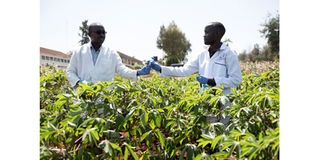Innovation, research key to food security

Agricultural researchers from the Kenya Agriculture and Livestock Research Organization (KALRO) have been working to produce drought-resistant crops to maximize crop outputs for smallholder farmers in Kenya’s rural areas. PHOTO | COURTESY/KALRO
What you need to know:
Universities have a role in addressing the problem of the rural household poverty through generating research around seed technologies, better planting methods, soil analysis techniques, mitigating the impacts of climate change and post-harvest loss management.
To do this, we need to create model innovation centres that would be micro-financed and managed by the institutions for downstream promotion of research and innovation outputs.
The government has yet again opened the door for the importation of maize to plug our perennial production deficit. Ironically, the announcement by Agriculture Chief Administrative Secretary Andrew Tuimur this week that the country needs 12.5 million bags of the staple by the end of the month comes hot on the heels of the drop in budgetary allocation to food security.
JOB CREATION
The decline in local productivity has pushed the country to import virtually every important food crop from such countries as China, South Africa, Uganda, Mexico and Tanzania.
Considering that agriculture accounts for 34 per cent of the Gross Domestic Product, a lot more attention should have been given it, with the emphasis being on the smallholder farmers. This was not the case. The amount allocated to agriculture, food security and nutrition has been very minimal since 2016 where we’ve seen allocation declining from 3.5 per cent to the current 2.9 per cent. This is unacceptable for a sector that contributes between 50 and 70 per cent in job creation.
With a reduced budget and the unavailability of sufficient food from the smallholder farmers, market forces will adjust prices of food due to demand leading to unaffordability.
Food stands out as an important factor in advancing the national socio-economic development. Yet Kenya’s fiscal policies on agriculture give preference to industrial agriculture. There is urgent need for the government to turn to innovations that will hasten the growth of smallholder farmers. President Uhuru Kenyatta’s other legacy projects – manufacturing, universal healthcare and affordable housing – will not succeed with a hungry population.
STRATEGIC CENTRE
The route to Kenya’s food security is the smallholder way. Past large-scale farming efforts to contain food security have failed spectacularly. How much food would the Sh7.2 billion that was sunk into the Galana-Kulalu wilderness have produced? How many stallholder farmers would the cash have uplifted?
To put our food security policies on a firm ground, we need to put to use the tonnes of research gathering dust in our universities.
The food security challenge has often been attributed to climate change, but the problem really has been a weak linkage in the dissemination of research information and innovations to farmers.
There are low-cost technologies that can improve the socio-economic power of the small-scale farmers.
Universities have a role in addressing the problem of the rural household poverty through generating research around seed technologies, better planting methods, soil analysis techniques, mitigating the impacts of climate change and post-harvest loss management. To do this, we need to create model innovation centres that would be micro-financed and managed by the institutions for downstream promotion of research and innovation outputs. Such a strategic centre of excellence would be replicated in the counties where the innovations would be introduced and upgrading of skills done through extension services.
Mr Njoroge, an innovator working at Mount Kenya University, is the winner of the Global Innovation Through Science and Technology 2019 Award; [email protected]




